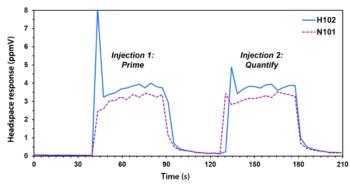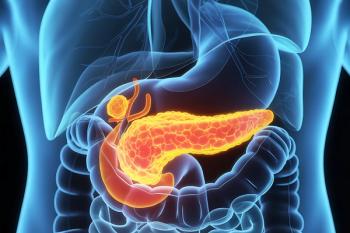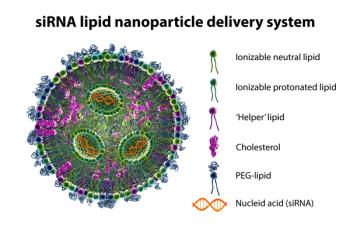
Using GC-MS to Measure Improvement Efforts to TNT-Contaminated Soil
Researchers developing a plant microbial consortium that can repair in-situ high concentration TNT (1434 mg/kg) contaminated soil, as well as overcome the limitations of previous studies that only focused on simulated pollution, used untargeted metabolone gas chromatography-mass spectrometry (GC-MS) to measure their success.
A joint study between the State Key Laboratory of Chemistry for NBC Hazards Protection (Beijing, China) and the Southwest University of Science and Technology (Mianyang, China) set out to uncover the efficiency, metabolic potential, and microbial community structure in high-concentration 2,4,6-trinitrotoluene (TNT)-contaminated soils following combined remediation. Untargeted metabolome gas chromatography-mass spectrometry (GC-MS) analysis revealed that the combined remediation restored fatty acid metabolism, amino acid metabolism, and sugar metabolism pathways in TNT-contaminated soil. A paper based on this study was published in Ecotoxicology and Environmental Safety (1).
Modern warfare, military conflicts, and military exercises all use arms and ammunition (2), releasing large amounts of TNT and other explosive materials into the environment through the processes of the explosive’s synthesis, charging, detection, disassembly, and destruction (3). Explosive materials such as these are highly toxic substances which often contaminate the environment in which they are detonated, particularly in the soil (4).
The search for environmentally friendly TNT disposal technology for TNT contamination has become a research focus recently; common disposal methods for explosive pollutants currently include thermal treatment (incineration), physical and chemical methods (such as chemical reduction, in-situ chemical reaction, electrochemical method, lime treatment, and chemical oxidation), and biodegradation/remediation (5,6). While research has shown that plant-microbial remediation systems have good remediation effects (7) high TNT concentrations and toxicity limit the application of phytoremediation, as soils contaminated with TNT concentrations higher than 1000 mg/kg often lack plant cover (8,9) In addition, the growth of most organisms, when exposed to higher TNT concentrations (250 mg/l), is negatively affected (10). This inspired the researchers involved in the study to fill what they perceive to be an urgent need to enhance phytotolerance and remediation efficiency to allow restoration of soils with high TNT contamination (1).
In this study, the experimental materials were five TNT-degrading plant species: V. zizanioides, Medicago sativa L., Lolium perenne L., Trifolium pratense L., and Pennisetum alopecuroides (L.) Spreng. The effective microorganisms (EM) were a compound microbial mixture that was domesticated and compounded by the research group. Its constituent strains were Klebsiella variicola, Klebsiella sp., Bacillus aryabhatta, photosynthetic bacteria, lactic acid bacteria, actinomycetes, yeasts, and fermentation filamentous bacteria. High-concentration TNT-contaminated soil (1000–1200 mg/kg TNT) was obtained from a destruction site, with samples were collected by using a five-point sampling method after plants had grown in the soil for 60 days (1).
A total of 266 soil metabolites were identified in the groups by GC-MS nontargeted metabolomics analysis, consisting mainly of organic acids and derivatives, organic oxygen compounds, and lipids and lipid-like molecules, showing that the combined remediation restored fatty acid metabolism, amino acid metabolism, and sugar metabolism pathways in TNT-contaminated soil (1).
The researchers report that their analysis revealed a change in the microbial community and species richness of the soil, as well as an acceleration of the degradation of TNT in soil, a promotion of the soil’s metabolic cycle of soil, and a restoration of the contaminated soil. They further state that the changes in key soil environmental factors and microbial reconstruction reveal the mechanism of plant-microbial restoration of TNT-contaminated soil, proving that combined plant-microbial remediation can improve the function of soils highly contaminated with TNT (1).
References
1. Han, M.; Lai, J.; Zhu, Y. et al. The mechanism of Plants and Effective Microorganisms Combined Remediation of Heavily TNT-Contaminated Soil. Ecotoxicol. Environ. Saf. 2025, 297, 118169. DOI:
2. Fernandez-Lopez, C.; Posada-Baquero, R.; Ortega-Calvo, J. J. Nature-Based Approaches to Reducing the Environmental Risk of Organic Contaminants Resulting from Military Activities. Sci. Total Environ. 2022, 843, 157007. DOI:
3. Lata, K.; Kushwaha, A.; Ramanathan, G. Bacterial Enzymatic Degradation and Remediation of 2, 4, 6-Trinitrotoluene. Microb. Nat. Macromol. 2021, 623-659. DOI:
4. Gupta, S.; Goel, S. S.; Siebner, H. et al. Transformation of 2, 4, 6-Trinitrotoluene by Stenotrophomonas Strain SG1 Under Aerobic and Anaerobic Conditions. Chemosphere 2023, 311, 137085. DOI:
5. Li, J.; Zhou, Q.; Li, M. et al. Monodisperse Amino-Modified Nanosized Zero-Valent Iron for Selective and Recyclable Removal of TNT: Synthesis, Characterization, and Removal Mechanism. J. Environ.Sci. 2021, 103, 69-79. DOI:
6. Yang, Z.: Chen, J.; Zhou, Y. Understanding the Hydrogen Transfer Mechanism for the Biodegradation of 2, 4, 6-Trinitrotoluene Catalyzed by Pentaerythritol Tetranitrate Reductase: Molecular Dynamics Simulations. Phys. Chem. Chem. Phys. 2018, 20 (17), 12157-12165. DOI:
7. Rocheleau, S.; Lachance, B.; Kuperman, R. G. et al. Toxicity and Uptake of Cyclic Nitramine Explosives in Ryegrass Lolium perenne. Environ. Pollut. 2008, 156 (1), 199-206. DOI:
8. Siciliano, S. D.; Greer, C. W. Plant‐Bacterial Combinations to Phytoremediate Soil Contaminated with High Concentrations of 2, 4, 6‐Trinitrotoluene (Vol. 29, No. 1, pp. 311-316). American Society of Agronomy, Crop Science Society of America, and Soil Science Society of America, 2000. DOI:
9. Fuller, M. E.; Manning Jr, J. F. Evidence for Differential Effects of 2, 4, 6‐Trinitrotoluene and Other Munitions Compounds on Specific Subpopulations of Soil Microbial Communities. Environ. Toxicol. Chem. 1998, 17 (11), 2185-2195. DOI:
10. Cabrera, M. Á.; Márquez, S. L.; Quezada, C. P. et al. Biotransformation of 2, 4, 6-Trinitrotoluene by Pseudomonas sp. TNT3 Isolated from Deception Island, Antarctica. Environ. Pollut. 2020, 262, 113922. DOI:
Newsletter
Join the global community of analytical scientists who trust LCGC for insights on the latest techniques, trends, and expert solutions in chromatography.





